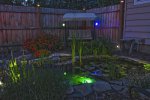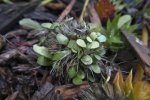JBtheExplorer
Native Gardener
Some of you know about my native garden, but I also have a goldfish pond. It sits next to my patio, right between my house and garage. For those who've never seen it before, here it is:

When I initially built the pond, the plants I bought were pretty much anything I could find on clearance. I was on a tight budget. Of course, since then, I've learned a lot more about native plants and their importance. I've also learned that buying seeds is the most affordable way to go, which I always knew, but never knew if I could be patient enough, or if I could even successfully grow them, but I figured it all out fairly quickly
The photo below shows my original native plant area by the pond that I added in 2014. Purple Coneflower was added just last year and bloomed for the first time this Summer. I also have Orange Milkweed, Blanket Flower, and Black-eyed Susans.


Over the last year, I've started replacing the non native plants for native species. I've removed maybe a dozen non-native species. This Autumn, I ripped out the last of the daylilies. I put Blazing Star in it's spot, which was a plant that was already growing along my pond. Where the Blazing Star originally was, I planted about 15 Blue-eyed Grass plants, as well as a Nodding Onion and Penstemon. Blue-eyed Grass is a low-growing native, so I'll have a good view of the pond.
Here's the Blazing Star
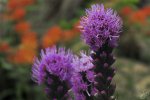
...and the Blue-eyed Grass.
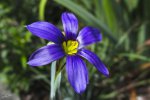
Earlier this year, I added Bush's Coneflower seedlings, which I'm hoping to see bloom in 2017. If you've never heard of them, they're the only naturally yellow Echinacea. In Spring, I added a Wild Geranium plant, which is another plant that should bloom next year. The only photo I have of it was taken this November as it was turning red.
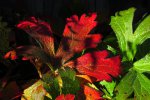
In my pond, I have a few native plants as well. Horsetail Rush, Blue Flag Iris, and Smooth Black Sedge are all native to my area.
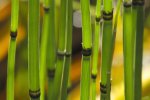
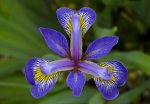
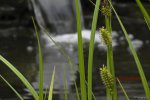
While I'd like to convert the pond area to 100% true native species, I'm not sure I will, at least not right now. I enjoy my different-colored waterlilies. I also like the way Dianthus looks by my pond (in the second photo, just to the left of the pond, with a duck egg in it). Frogs also like sitting in it.
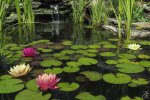
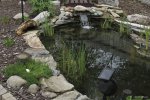
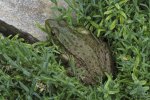
I may not get to 100% native, but I'm pushing for 95%. In 2017, I have more plans to continue the conversion to a native garden. I may remove three or four more non-native species to make room for more native plants. I'm hoping to add Meadow Blazing Star, which is known for attracting Monarch Butterflies. I already grow it in my native garden, and have seen how Monarchs fly to it like a magnet.

I may figure out ways to squeeze in more plants too. Smooth Oxeye is a favorite that I'd like to see in the pond area, but for now, I'll have plenty of time to plan it all out. I'll have to wait about two or three months for the snow to melt, and then another month or two before I can plant.
Regardless, the project continues!
When I initially built the pond, the plants I bought were pretty much anything I could find on clearance. I was on a tight budget. Of course, since then, I've learned a lot more about native plants and their importance. I've also learned that buying seeds is the most affordable way to go, which I always knew, but never knew if I could be patient enough, or if I could even successfully grow them, but I figured it all out fairly quickly
The photo below shows my original native plant area by the pond that I added in 2014. Purple Coneflower was added just last year and bloomed for the first time this Summer. I also have Orange Milkweed, Blanket Flower, and Black-eyed Susans.
Over the last year, I've started replacing the non native plants for native species. I've removed maybe a dozen non-native species. This Autumn, I ripped out the last of the daylilies. I put Blazing Star in it's spot, which was a plant that was already growing along my pond. Where the Blazing Star originally was, I planted about 15 Blue-eyed Grass plants, as well as a Nodding Onion and Penstemon. Blue-eyed Grass is a low-growing native, so I'll have a good view of the pond.
Here's the Blazing Star

...and the Blue-eyed Grass.

Earlier this year, I added Bush's Coneflower seedlings, which I'm hoping to see bloom in 2017. If you've never heard of them, they're the only naturally yellow Echinacea. In Spring, I added a Wild Geranium plant, which is another plant that should bloom next year. The only photo I have of it was taken this November as it was turning red.

In my pond, I have a few native plants as well. Horsetail Rush, Blue Flag Iris, and Smooth Black Sedge are all native to my area.



While I'd like to convert the pond area to 100% true native species, I'm not sure I will, at least not right now. I enjoy my different-colored waterlilies. I also like the way Dianthus looks by my pond (in the second photo, just to the left of the pond, with a duck egg in it). Frogs also like sitting in it.



I may not get to 100% native, but I'm pushing for 95%. In 2017, I have more plans to continue the conversion to a native garden. I may remove three or four more non-native species to make room for more native plants. I'm hoping to add Meadow Blazing Star, which is known for attracting Monarch Butterflies. I already grow it in my native garden, and have seen how Monarchs fly to it like a magnet.
I may figure out ways to squeeze in more plants too. Smooth Oxeye is a favorite that I'd like to see in the pond area, but for now, I'll have plenty of time to plan it all out. I'll have to wait about two or three months for the snow to melt, and then another month or two before I can plant.
Regardless, the project continues!



 Another advantage to growing from seed is that you can be sure your plants are free of any sorts of toxins that the grower and/or garden center may have used on the plants. I see your solar panel there. Does it power the pump for the pond? I have a similar sized solar panel for the birdbath and i let it run all day, guilt free. Did you convert the pump from ac/dc to solar? or did you purchase the two items as a package?
Another advantage to growing from seed is that you can be sure your plants are free of any sorts of toxins that the grower and/or garden center may have used on the plants. I see your solar panel there. Does it power the pump for the pond? I have a similar sized solar panel for the birdbath and i let it run all day, guilt free. Did you convert the pump from ac/dc to solar? or did you purchase the two items as a package?
